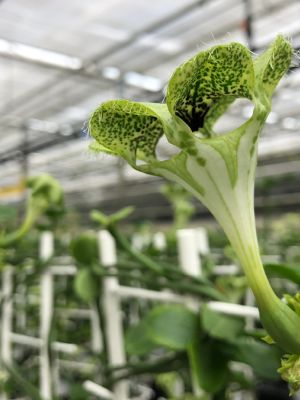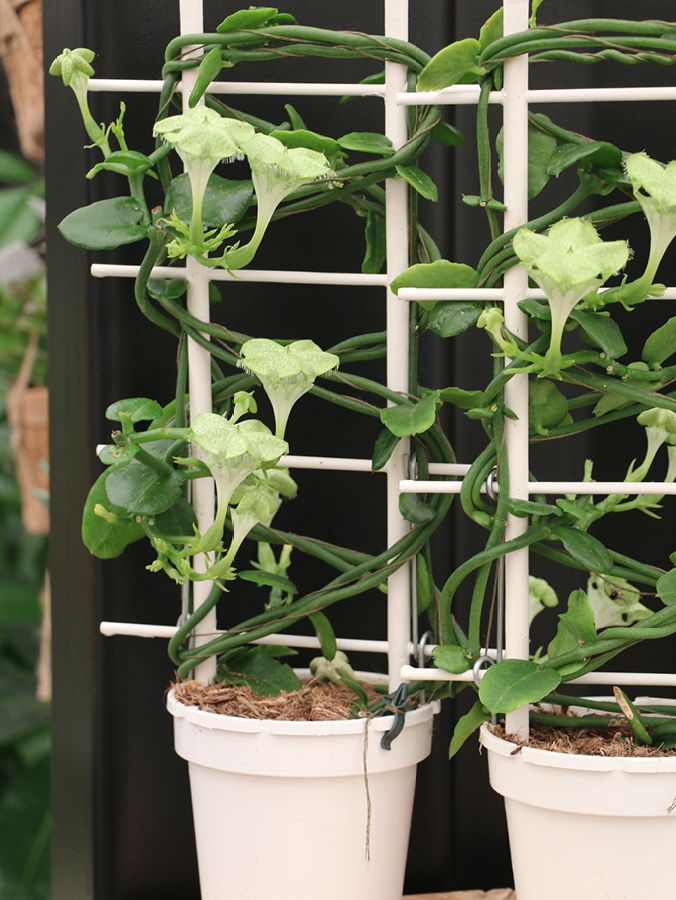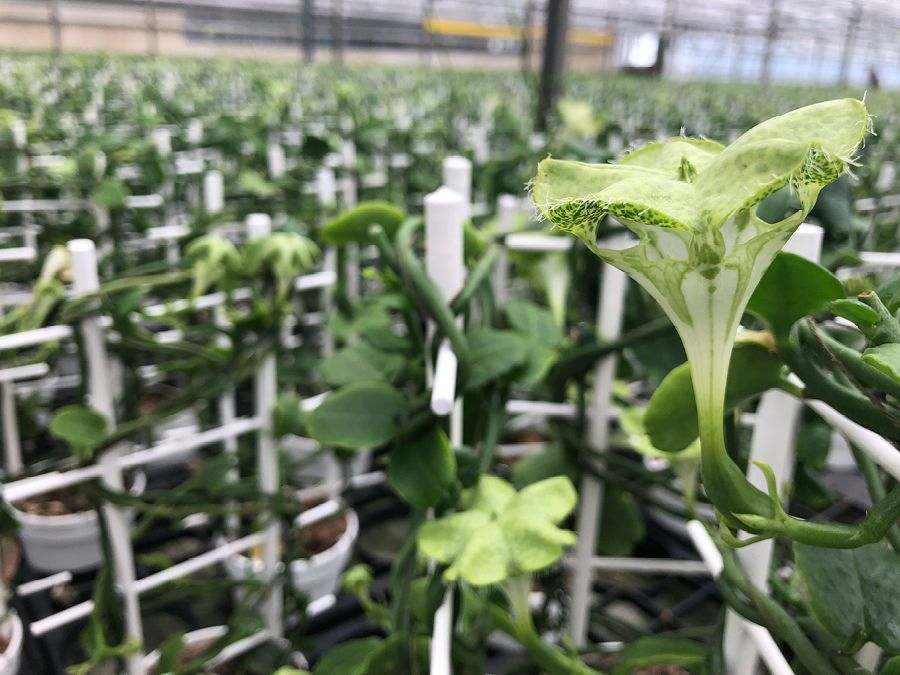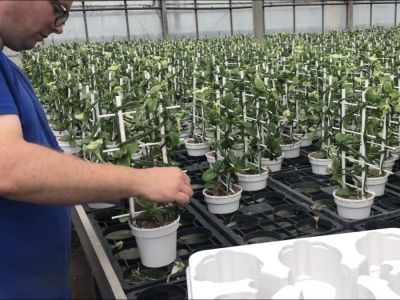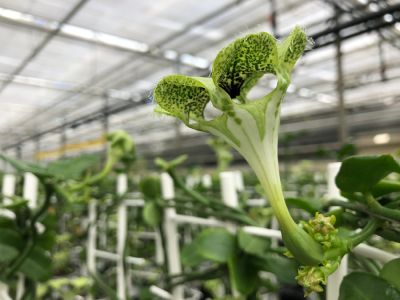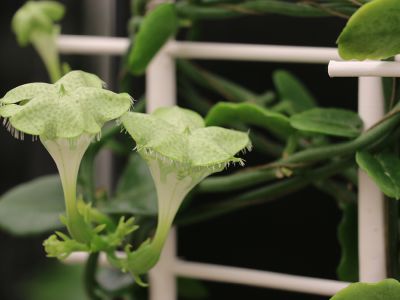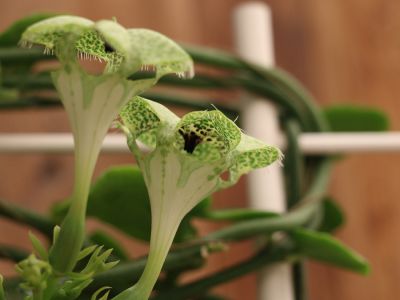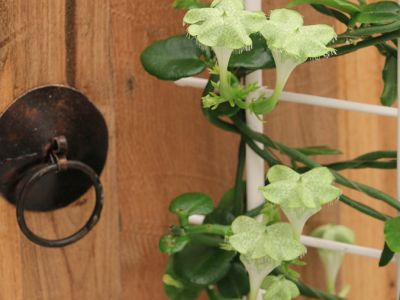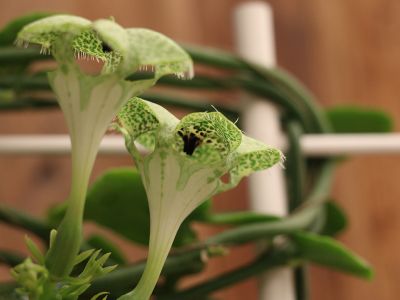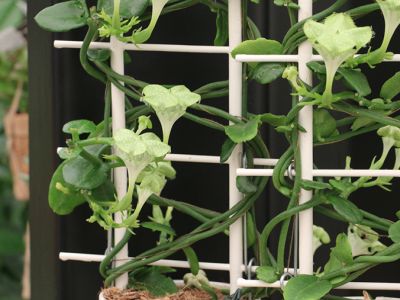Ceropegia sandersonii
In the spotlights
Ceropegia is also popularly called lantern plant. There are 200 different Ceropegia species. The most famous is the Ceropegia woodii, the hanging lantern plant. During our visit to nursery Hoogendoorn Stephanotis we noticed a Ceropegia variety with a flower that really lives up to the name "lantern plant"; the Ceropegia sandersonii, also called African Parachute Plant. Hans told us everything about this eccentric, trendy plant and the challenge to make this plant more known.
Characteristics
The Ceropegia sandersonii has its origins in Mozambique, Transvaal and Natal in South Africa and belongs to the Asclepiadaceae family. Characteristic of this family is the wolf's milk in the stems. When the Ceropegia is bruised it ‘bleeds’ wolf’s milk from both the leaves and the stem.
A large number of species of this genus are succulents; plants that store water inside the plant. Some species store the water in the leaf, others in the stem or root. In the natural environment of the succulent, it is warm and dry, and the plant creates its own water reservoir after a rainy period to survive the dry periods.
The Ceropegia sandersonii is characterized by its separate winding stems with small, fat-like leaves. The most special thing about this plant is its flowers. They grow in clusters and look like parachutes. Where most flowers have bright colors, this flower has a light green tiger print with fringes along the edges. Besides looking quite special, they also smell very nice! They spread a nice fresh lime-like scent. During the rainy season the plant develops flowers, during dry periods the plant goes into survival mode and can then live without water for a long time.
Fly trap
The lovely lime scent only attracts female flies. These very small flies enter the parachute flower planning to lay eggs. In the flower tube are oil cells and tiny hairs, which are at an angle of 90 degrees. Because of the oil and the hairs, the flies can get in, but can’t get out. The fly is lured even further into the flower by a number of light-transmitting cells , where the flower produces its sweeteners. While the fly feeds on all this sweetness, the pollen stick to the fly. Only when the flower starts to bloom after a few days, does the flower turn over. This causes the flower tube to stand up and the flies can get out again and make their way to the next flower with legs full of pollen, in that way fertilizing the next flower they visit.

Care
With sufficient light, the plant blooms year-round and keeps creating new branches that will also produce new flower clusters. The new tendrils are being led in a round shape, making the plant grow in a beautiful arc.
The development of each individual flower takes approximately three weeks. It’s easier for the plant to grow flowers on new young branches. So, if the plant becomes too long or too large, the plant should be pruned. Remove the old wood and allow the branches to grow out again from the base.
The Ceropegia is an easy, strong plant with few problems. The plant wants a light place but with little direct sunlight with a temperature of around 16 to 25 degrees Celsius. A little water once a week is enough.
The plant can also appreciate a shower from a plant sprayer. The soil may therefore be slightly moist. To provide an extra boost you can give the plant some plant food once every three weeks. Sometimes some lice can occur in the plant, but in general the plant has few problems with pests and diseases.
The cultivation
The Hoogendoorn company was founded in 1929 by Hans' grandfather. He initially grew tomatoes and other vegetables. In the late 1960s, the company switched to cut flowers and then to plants. Hoogendoorn is primarily specialized in growing Stephanotis. In order to be able to offer his customers a more attractive assortment, he has added a small-scale cultivation of Ceropegia and Hoya.
Two crops, same method!
The process to produce ready to be sold plants takes about 14 months; quite a long time! The Ceropegia has the same type of cultivation method as the Stephanotis. That is why the two products can be grown together under the same conditions. The Ceropegia is propagated throughout the year. The cuttings that are used to start the plants are made by the company itself. This is the most difficult part of the entire cultivation process and a lot of small plants are lost during that stage. Once the Ceropegia has passed this stage, the fun really starts!
When the plants starts to grow, they are tied to a string just like the Stephanotis after which they start climbing further up the string. In this growth phase, the plant produces flower buds that are as small as pin buds. If the plant has sufficient length, it is rotated in the rack after which they can grow further. They are then placed in a section with extra light and a slightly warmer temperature. This makes the flowers larger and enables them to grow into the well-known lanterns.
Crazy colors
The plant has green branches with green flowers. A somewhat shy plant actually, that doesn't really stand out because it lacks bright colors. The biggest challenge of the company is therefore to get this lovely plant noticed.
A white wooden rack did not stand out. The plant was pulled out of its shy position by tying it in colored racks in blue, green, purple, orange, yellow and white. The product was put on the market with a recognizable logo in the same colors. Now nobody can ignore this great product!
FloraPodium, 12 August 2019






